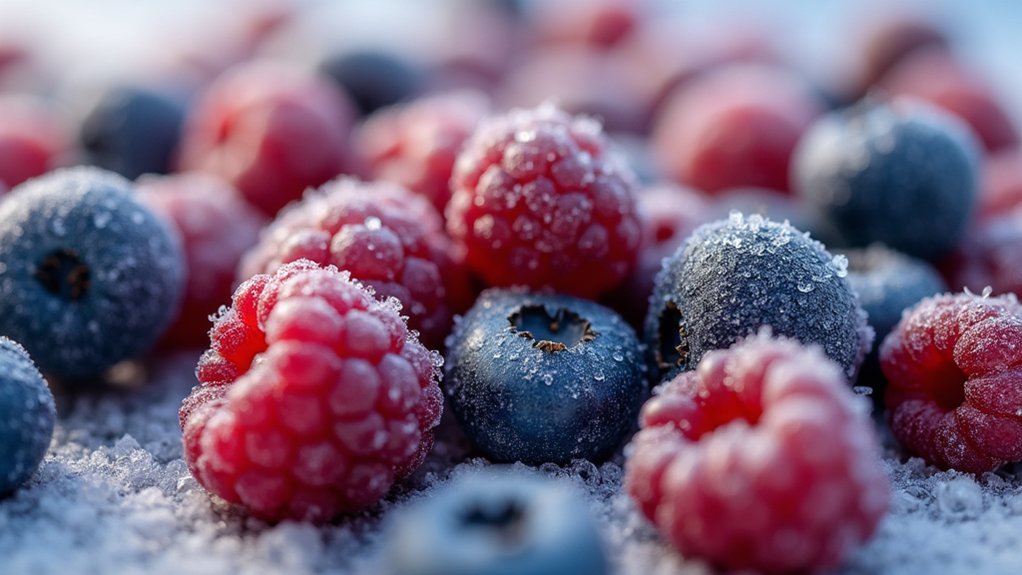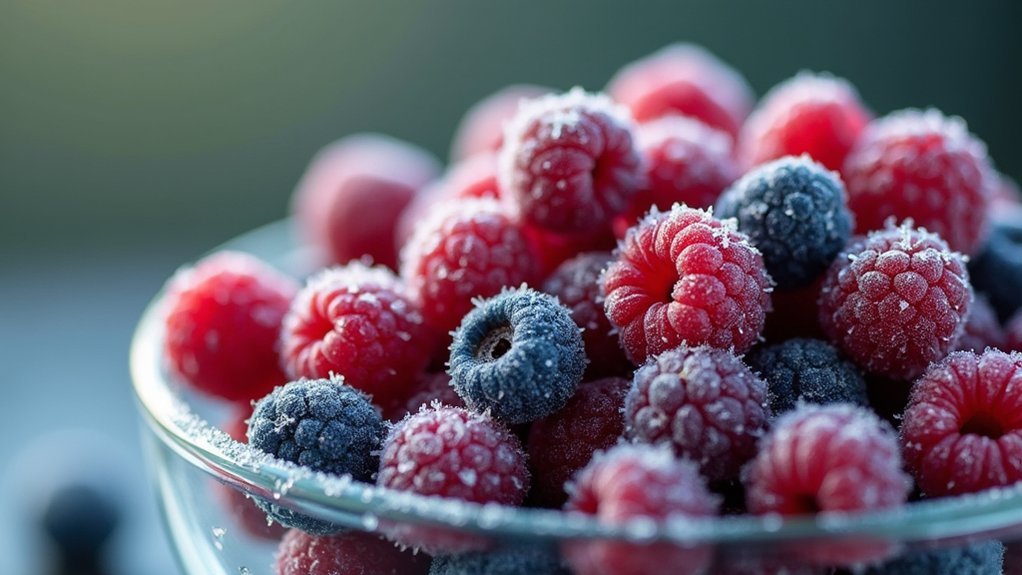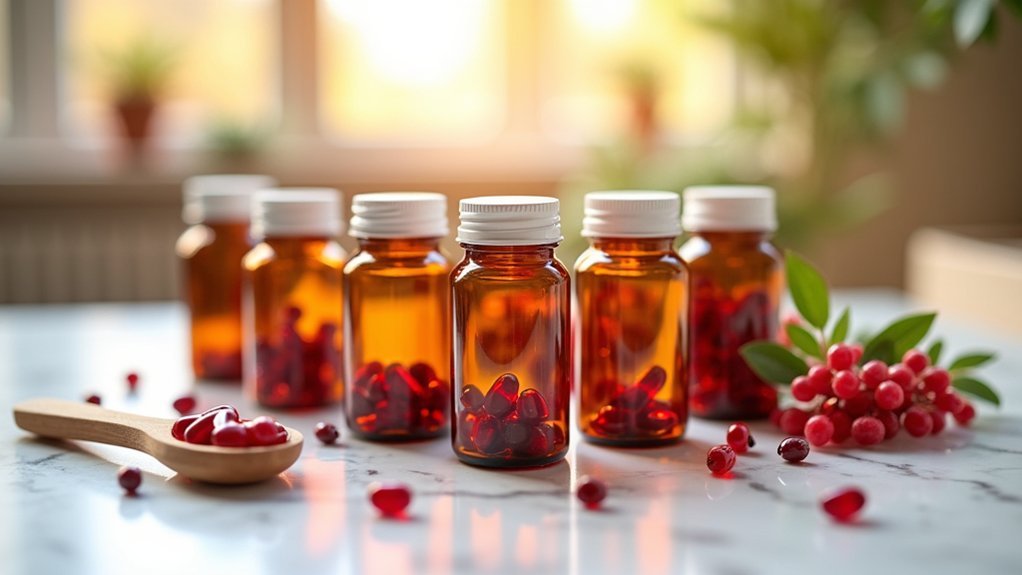You’ll maximize frozen berries’ cellular protection by choosing Individual Quick Freezing (IQF) methods that preserve anthocyanins and storing them at -18°C to maintain antioxidant capacity. Apply cryoprotectant solutions before freezing to minimize nutrient loss, then thaw slowly in refrigerated conditions to protect cell structure. Select wild berries for higher bioflavonoid concentrations, consider freeze-drying for stable phytochemical storage, and use nonthermal processing technologies to retain up to 99% of vitamin C. These techniques reveal berries’ full protective potential.
Choose Individual Quick Freezing Methods to Preserve Anthocyanins and Phenolics

When you’re selecting frozen berries for maximum cellular protection, you’ll want to prioritize those processed using Individual Quick Freezing (IQF) methods.
IQF rapidly freezes berries, preventing large ice crystals that damage cells and degrade valuable anthocyanins and phenolics. This quick freezing process maintains anthocyanin concentrations close to fresh berry levels, while slower freezing methods allow more cellular disruption and nutrient loss.
IQF processing prevents cellular damage by rapidly freezing berries, preserving anthocyanins and phenolics at levels comparable to fresh fruit.
You’ll find IQF berries retain their individual structure without clumping together, ensuring uniform freezing throughout. The rapid process also reduces enzymatic degradation that breaks down these protective compounds.
Studies consistently show IQF-processed berries preserve antioxidant profiles better than conventional freezing methods, with anthocyanin values ranging from 3.32 to 8.89 mg/g. Frozen wild blueberries can be stored for over two years without loss of nutritional value or flavor.
Choose IQF for maximum bioactive compound retention.
Store Frozen Berries at -18°C to Retain Maximum Antioxidant Capacity
Proper storage temperature makes all the difference in preserving your frozen berries’ antioxidant power. Store your berries at -18°C to maintain their nutritional value and bioactive compounds effectively. This standard freezing temperature stabilizes anthocyanins and preserves polyphenols, ensuring your berries retain their cellular protection capabilities.
You’ll find that consistent temperature regulation prevents antioxidant degradation. While storage at -32°C might retain slightly more polyphenols, -18°C provides sufficient preservation for maximum antioxidant capacity. Avoid temperature fluctuations, which can reduce your berries’ protective compounds.
Frozen berries stored properly at -18°C often maintain higher antioxidant levels than fresh berries over time. You can store them for several months without significant antioxidant loss, making frozen berries an excellent choice for long-term cellular protection. The most significant reductions occur within the first three months, so consume your frozen berries within this timeframe for optimal antioxidant benefits.
Use Cryoprotectant Solutions During Freezing to Minimize Nutrient Loss

Although freezing preserves berries effectively, you can greatly reduce nutrient loss by applying cryoprotectant solutions before the freezing process. These solutions work by preventing ice crystal formation inside cells, which minimizes mechanical damage and preserves membrane integrity.
You’ll find several effective cryoprotectant options. Dip your berries in sugar solutions or syrups to protect texture while enhancing nutrient retention. Ascorbic acid solutions provide dual benefits—they act as cryoprotectants while preventing enzymatic browning and oxidation.
Polyols like glycerol replace water molecules, stabilizing proteins and membranes during freezing. For best results, pre-treat berries with these solutions before tray freezing. Remember that freezing does not eliminate microorganisms but prevents their growth at 0°F (-17°C).
This combination maintains antioxidant activity, preserves vitamin C content, and extends frozen storage life up to ten months while keeping quality comparable to fresh fruit.
Thaw Berries Slowly in Refrigerated Conditions to Maintain Cell Structure
You’ll achieve the best cellular protection by thawing your frozen berries slowly in refrigerated conditions rather than at room temperature.
This controlled thawing process maintains ideal temperatures that preserve berry firmness and prevent excessive juice loss from damaged cell walls.
The gradual temperature shift minimizes additional cellular damage while keeping your berries’ structure as intact as possible. Refrigerator thawing also helps maintain food safety by preventing harmful bacteria growth that can occur at warmer temperatures.
Optimal Refrigerated Thawing Temperature
When you thaw frozen berries in refrigerated conditions, you’ll preserve their cellular structure and maintain ideal texture. Set your refrigerator to 40°F (4°C) or below to guarantee food safety while preventing bacterial growth.
This controlled temperature creates gradual thawing that protects berry cell walls from rupturing, reducing juice loss and mushiness. Lower temperatures slow ice crystal formation and melting, which preserves the berries’ firm texture and natural appearance.
Consistent refrigerator temperature prevents uneven thawing that can damage cellular integrity. Place berries in a covered bowl or airtight container, allowing 4-6 hours for small quantities or overnight for larger amounts. Remember to save the natural juices that release during thawing, as these contain concentrated flavors and nutrients that work perfectly in sauces or dessert preparations.
This slow method maintains flavor compounds, antioxidant content, and color while preventing enzymatic browning and oxidation.
Preventing Juice Loss
Beyond maintaining ideal temperature, the method you choose for thawing directly impacts how much juice your berries retain.
When you thaw berries slowly in refrigerated conditions, you’re protecting damaged cell walls from further rupture that occurs with rapid temperature changes. This controlled approach minimizes the osmotic shock that accelerates juice leakage.
Follow these essential steps to preserve your berries’ cellular integrity:
- Keep berries in original packaging to prevent environmental moisture infiltration
- Use refrigerator-only thawing for uniform temperature control
- Avoid water submersion which increases cellular damage
- Allow complete thawing time to prevent partial thawing and cellular collapse
Scientific studies confirm that slower thawing methods maintain better cell structure, resulting in firmer texture and markedly less visible juice release compared to quick-thawing techniques. Research shows that gradient thawing methods yield significantly lower drip loss than rapid thawing approaches, while maintaining optimal cellular integrity throughout the process.
Preserving Berry Firmness
Three critical factors determine whether your frozen berries maintain their firmness after thawing: the size of ice crystals formed during freezing, the temperature control during thawing, and the speed of cellular water movement.
You’ll preserve maximum firmness by freezing berries quickly at -29°C or lower, which creates smaller ice crystals that cause less cell wall damage.
When thawing, keep berries in refrigerated conditions rather than at room temperature. This slower process reduces ice crystal melting stress and minimizes large-scale water movement from cells.
Thaw berries in their original sealed packaging to prevent moisture loss and air exposure.
Store frozen berries at -18°C or below to prevent ice recrystallization that further damages cellular structure.
Select Wild Berries for Higher Concentrations of Protective Bioflavonoids
Since wild berries contain considerably higher concentrations of protective bioflavonoids than their commercial counterparts, they’re your best choice for maximizing cellular protection benefits.
Wild Alaskan berries like lowbush cranberries pack twice the phenolic content of commercial varieties, delivering superior antioxidant power.
When selecting wild berries, prioritize these varieties for maximum bioflavonoid content:
- Wild blueberries – exceptionally high in anthocyanins and total phenolic content
- Lowbush cranberries – rich in proanthocyanidins and twice the phenolics of commercial cranberries
- Wild lingonberries – abundant in diverse flavonoids and anti-inflammatory compounds
- Wild blackberries – loaded with anthocyanins and varied phenolic compounds
You’ll get enhanced cellular protection from these wild varieties’ concentrated bioflavonoids, which provide superior antioxidant capacity and anti-inflammatory effects compared to cultivated berries. Wild blueberries thrive in acidic soils with optimal pH levels around 4.5, which allows them to absorb higher mineral concentrations that contribute to their exceptional nutritional profile.
Consider Freeze-Drying as an Alternative Method for Stable Phytochemical Storage

You’ll find freeze-drying offers superior preservation of berry antioxidants compared to traditional freezing methods.
This process maintains phytochemical quality by removing moisture while keeping beneficial compounds intact, extending your berries’ shelf life considerably. The three main stages of freeze-drying – freezing, primary drying through sublimation, and secondary drying – work together to preserve bioactive components more effectively than conventional preservation methods.
You can control storage temperature more effectively with freeze-dried berries, ensuring stable antioxidant levels for months without refrigeration.
Freeze-Drying Preserves Antioxidants
When you’re looking for the most effective way to preserve berries’ cellular-protective compounds, freeze-drying stands out as a superior alternative to traditional preservation methods.
This process maintains high levels of vitamin C, β-carotene, and total phenolics while avoiding the high-temperature degradation that destroys antioxidants in conventional drying.
Among berry varieties, bilberry maintains exceptionally high polyphenol and anthocyanin content even after processing.
You’ll benefit from these key advantages:
- Enhanced anthocyanin preservation – These potent antioxidants remain more intact than in air-dried berries
- Stable phytochemical retention – Low temperatures and vacuum conditions prevent oxidative breakdown
- Cellular structure protection – Sublimation preserves the fruit matrix that houses antioxidant molecules
- Extended shelf life – Freeze-dried berries maintain antioxidant capacity comparable to fresh produce for months
Your freeze-dried berries deliver maximum cellular protection.
Temperature Controls Shelf Life
Storage temperature becomes the deciding factor in how long your freeze-dried berries retain their cellular-protective power. Lower temperatures during freeze-drying preserve phytochemicals better than higher temperatures, while vacuum conditions minimize oxidation of sensitive compounds.
You’ll extend shelf life considerably through moisture removal, creating products that maintain potency for 1-2 years without deterioration.
Your storage environment matters just as much. High humidity accelerates phytochemical degradation, while consistent cool temperatures and low humidity maintain stability.
Choose packaging materials that control light and oxygen exposure, since direct sunlight causes color and nutritional value loss.
The porous structure of freeze-dried berries allows quick rehydration while preserving anthocyanins and phenolic compounds better than traditional air drying methods. Freeze-drying achieves 1.5-2.5% moisture content, creating optimal preservation conditions that significantly outperform convective drying for maintaining antioxidant activity.
Phytochemical Quality Retained
While traditional preservation methods often compromise nutritional value, freeze-drying stands out as the superior technique for maintaining your berries’ phytochemical integrity.
Unlike air drying or thermal processing, freeze-drying preserves the bioactive compounds that make berries nutritional powerhouses.
You’ll benefit from enhanced phytochemical retention through:
- Vitamin C preservation – Freeze-drying retains considerably more vitamin C than conventional drying methods
- Anthocyanin stability – These powerful antioxidants remain intact, maintaining berries’ cellular protection properties
- Phenolic compound retention – Essential compounds for antioxidant activity stay bioavailable
- Reduced oxidation – Minimized nutrient degradation preserves antioxidant capacity
This preservation method guarantees you’re getting maximum cellular protection from your berries while enabling long-term storage without considerable phytochemical loss. Research institutions often utilize centralized platforms to manage and share data on nutritional preservation methods, enhancing collaboration among food scientists studying optimal storage techniques.
Apply Nonthermal Processing Technologies to Maximize Vitamin C Retention
Since traditional thermal processing methods can destroy up to 22.6% of vitamin C in berry products, you’ll want to contemplate nonthermal processing technologies that preserve these essential antioxidants.
High pressure processing (HPP) maintains 79-99% of vitamin C content while ensuring microbiological safety. You’ll see losses of less than 9% with HPP compared to significant degradation from heat treatments.
HPP technology preserves up to 99% of vitamin C while eliminating harmful microorganisms, far outperforming traditional heat-based processing methods.
Pulsed light treatment offers 61% better vitamin C retention than thermal pasteurization, while ozone treatment similarly outperforms traditional methods.
These technologies don’t just preserve vitamin C during processing—they enhance stability during storage too.
Before freezing, you should minimize tissue damage and consider microwave-assisted blanching over conventional methods. Microwave thawing also results in minimal changes to strawberry composition compared to other thawing methods.
Chemical blanching avoids heat degradation better than hot water or steam treatments.
Frequently Asked Questions
How Do Frozen Berries Compare to Fresh Berries for Cellular Protection Benefits?
You’ll get nearly identical cellular protection benefits from frozen berries compared to fresh ones. Freezing preserves antioxidants, anthocyanins, and anti-inflammatory compounds effectively, while offering better convenience and year-round availability.
What Daily Amount of Frozen Berries Provides Optimal Antioxidant and Anti-Inflammatory Effects?
You’ll get ideal antioxidant and anti-inflammatory effects from one cup (150g) of frozen berries daily. Even one-third cup provides significant disease risk reduction, but the full cup maximizes cellular protection benefits.
Can Frozen Berries Help Prevent Specific Diseases Like Cancer or Heart Disease?
You’ll benefit from frozen berries’ disease-fighting properties. They’re linked to reduced cancer risk through antioxidant DNA protection and lower heart disease risk by improving blood pressure and cholesterol levels effectively.
Do Different Berry Types Offer Varying Levels of Cellular Protection When Frozen?
Yes, different frozen berry types offer varying cellular protection levels. You’ll get higher vitamin C from chokeberry, more bioflavonoids from blueberries, and different antioxidant profiles that provide unique protective benefits for your cells.
How Long Do Cellular Protection Benefits Last After Consuming Frozen Berries?
You’ll experience peak cellular protection within hours of eating frozen berries, but benefits diminish as antioxidants are metabolized. For sustained protection, you need regular consumption since compounds have plasma half-lives of just hours.
In Summary
You’ve learned seven science-backed methods to maximize frozen berries’ cellular protection. You’ll preserve more anthocyanins by choosing IQF methods, storing at -18°C, and using cryoprotectants. You’ll maintain cell structure by thawing slowly in your refrigerator. You’ll boost bioflavonoids by selecting wild varieties. You’ll retain stable phytochemicals through freeze-drying and maximize vitamin C with nonthermal processing. Apply these techniques and you’ll release frozen berries’ full antioxidant potential for peak health benefits.





Leave a Reply